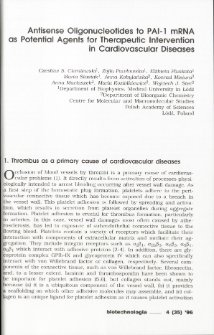
Obiekt
Tytuł: Antisense Oligonucleotides to PAM mRNA as Potential Agents for Therapeutic Intervention in Cardiovascular Diseases
Twórca:
Cierniewski, Czesław S. ; Pawłowska, Zofia ; Pluskota, Elżbieta ; Stasiak, Marta ; Kobylańska, Anna ; Misiura, Konrad ; Maciaszek, Anna ; Koziołkiewicz, Maria ; Stec, Wojciech J.
Data wydania/powstania:
Typ zasobu:
Inny tytuł:
Wydawca:
Komitet Biotechnologii PAN ; Instytut Chemii Bioorganicznej PAN
Opis:
Zeszyt specjalny. Polish - Japan Issue
Abstrakt:
Thrombolytic therapy provides clinical benefit in patients with vascular occlusions, dependingupon the organ or limb that is threated. The impact of therapeutic intervention varies from thequiet alteration of the course of deep vein thrombosis, for which non-life threatening postphlebitic syndrome can largely be avoided, to the striking reversal of pulmonary hypertensionand possible life-saving benefit in massive pulmonary embolism, the immediate alteration ofclinical course in acute peripheral arterial occlusion by reducing the need for surgical intervention, cardiopulmonary complication and one year mortality, and finally to the dramatic andlife-saving potential when applied in patients with acute myocardial infarction. At least threealternative and complementary approaches to improve thrombolytic therapy can be distinguished:a) earlier and accelerated treatment in order to reduce the duration of ischemia, b) developmentof alterative or engineered plasminogen activators with increased thrombolytic potency and/orspecific thrombolytic activity, in order to enhance coronary thrombolysis, and c) the use of morespecific and potent anticoagulant and antiplatelet agents for conjunctive use with thrombolyticagents, with the aim to accelerate recanalization and prevent reocclusion. In this report wediscuss the possibility of using antisense oligonucleotides specific to PAJ-l mRNA to reversiblydecrease PAI-1 level in blood plasma and thus prolong a half-life time of endogenous plasminogenactivators in circulation.
Czasopismo/Seria/cykl:
Biotechnologia, vol.35, 4 (1996)-.
Tom:
Zeszyt:
Strona pocz.:
Strona końc.:
Szczegółowy typ zasobu:
Format:
Identyfikator zasobu:
0860-7796 ; oai:rcin.org.pl:146562 ; IChB B-31
Źródło:
Biblioteka Instytutu Chemii Bioorganicznej PAN
Język:
Język streszczenia:
Zakres czasowy:
Prawa:
Licencja Creative Commons Uznanie autorstwa-Na tych samych warunkach 4.0
Zasady wykorzystania:
Digitalizacja:
Instytut Chemii Bioorganicznej Polskiej Akademii Nauk
Lokalizacja oryginału:
Instytut Chemii Bioorganicznej Polskiej Akademii Nauk
Dofinansowane ze środków:
Dostęp:
Kolekcje, do których przypisany jest obiekt:
Data ostatniej modyfikacji:
9 lis 2020
Data dodania obiektu:
9 lis 2020
Liczba pobrań / odtworzeń:
36
Wszystkie dostępne wersje tego obiektu:
https://rcin.org.pl/ichb/publication/182240
Wyświetl opis w formacie RDF:
Wyświetl opis w formacie RDFa:
Wyświetl opis w formacie OAI-PMH:
| Nazwa wydania | Data |
|---|---|
| Antisense Oligonucleotides to PAM mRNA as Potential Agents for Therapeutic Intervention in Cardiovascular Diseases | 9 lis 2020 |
Obiekty Podobne
Cierniewski, Czesław S. Stasiak, Marta
Borkowska, Bożenna
Ziółkowski, Piotr Babula- Skowrońska, Danuta Kaczmarek, Małgorzata Cieśla, Agata Sadowski, Jan
Koziołkiewicz, Maria

 INSTYTUT ARCHEOLOGII I ETNOLOGII POLSKIEJ AKADEMII NAUK
INSTYTUT ARCHEOLOGII I ETNOLOGII POLSKIEJ AKADEMII NAUK
 INSTYTUT BADAŃ LITERACKICH POLSKIEJ AKADEMII NAUK
INSTYTUT BADAŃ LITERACKICH POLSKIEJ AKADEMII NAUK
 INSTYTUT BADAWCZY LEŚNICTWA
INSTYTUT BADAWCZY LEŚNICTWA
 INSTYTUT BIOLOGII DOŚWIADCZALNEJ IM. MARCELEGO NENCKIEGO POLSKIEJ AKADEMII NAUK
INSTYTUT BIOLOGII DOŚWIADCZALNEJ IM. MARCELEGO NENCKIEGO POLSKIEJ AKADEMII NAUK
 INSTYTUT BIOLOGII SSAKÓW POLSKIEJ AKADEMII NAUK
INSTYTUT BIOLOGII SSAKÓW POLSKIEJ AKADEMII NAUK
 INSTYTUT CHEMII FIZYCZNEJ PAN
INSTYTUT CHEMII FIZYCZNEJ PAN
 INSTYTUT CHEMII ORGANICZNEJ PAN
INSTYTUT CHEMII ORGANICZNEJ PAN
 INSTYTUT FILOZOFII I SOCJOLOGII PAN
INSTYTUT FILOZOFII I SOCJOLOGII PAN
 INSTYTUT GEOGRAFII I PRZESTRZENNEGO ZAGOSPODAROWANIA PAN
INSTYTUT GEOGRAFII I PRZESTRZENNEGO ZAGOSPODAROWANIA PAN
 INSTYTUT HISTORII im. TADEUSZA MANTEUFFLA POLSKIEJ AKADEMII NAUK
INSTYTUT HISTORII im. TADEUSZA MANTEUFFLA POLSKIEJ AKADEMII NAUK
 INSTYTUT JĘZYKA POLSKIEGO POLSKIEJ AKADEMII NAUK
INSTYTUT JĘZYKA POLSKIEGO POLSKIEJ AKADEMII NAUK
 INSTYTUT MATEMATYCZNY PAN
INSTYTUT MATEMATYCZNY PAN
 INSTYTUT MEDYCYNY DOŚWIADCZALNEJ I KLINICZNEJ IM.MIROSŁAWA MOSSAKOWSKIEGO POLSKIEJ AKADEMII NAUK
INSTYTUT MEDYCYNY DOŚWIADCZALNEJ I KLINICZNEJ IM.MIROSŁAWA MOSSAKOWSKIEGO POLSKIEJ AKADEMII NAUK
 INSTYTUT PODSTAWOWYCH PROBLEMÓW TECHNIKI PAN
INSTYTUT PODSTAWOWYCH PROBLEMÓW TECHNIKI PAN
 INSTYTUT SLAWISTYKI PAN
INSTYTUT SLAWISTYKI PAN
 SIEĆ BADAWCZA ŁUKASIEWICZ - INSTYTUT TECHNOLOGII MATERIAŁÓW ELEKTRONICZNYCH
SIEĆ BADAWCZA ŁUKASIEWICZ - INSTYTUT TECHNOLOGII MATERIAŁÓW ELEKTRONICZNYCH
 MUZEUM I INSTYTUT ZOOLOGII POLSKIEJ AKADEMII NAUK
MUZEUM I INSTYTUT ZOOLOGII POLSKIEJ AKADEMII NAUK
 INSTYTUT BADAŃ SYSTEMOWYCH PAN
INSTYTUT BADAŃ SYSTEMOWYCH PAN
 INSTYTUT BOTANIKI IM. WŁADYSŁAWA SZAFERA POLSKIEJ AKADEMII NAUK
INSTYTUT BOTANIKI IM. WŁADYSŁAWA SZAFERA POLSKIEJ AKADEMII NAUK
































